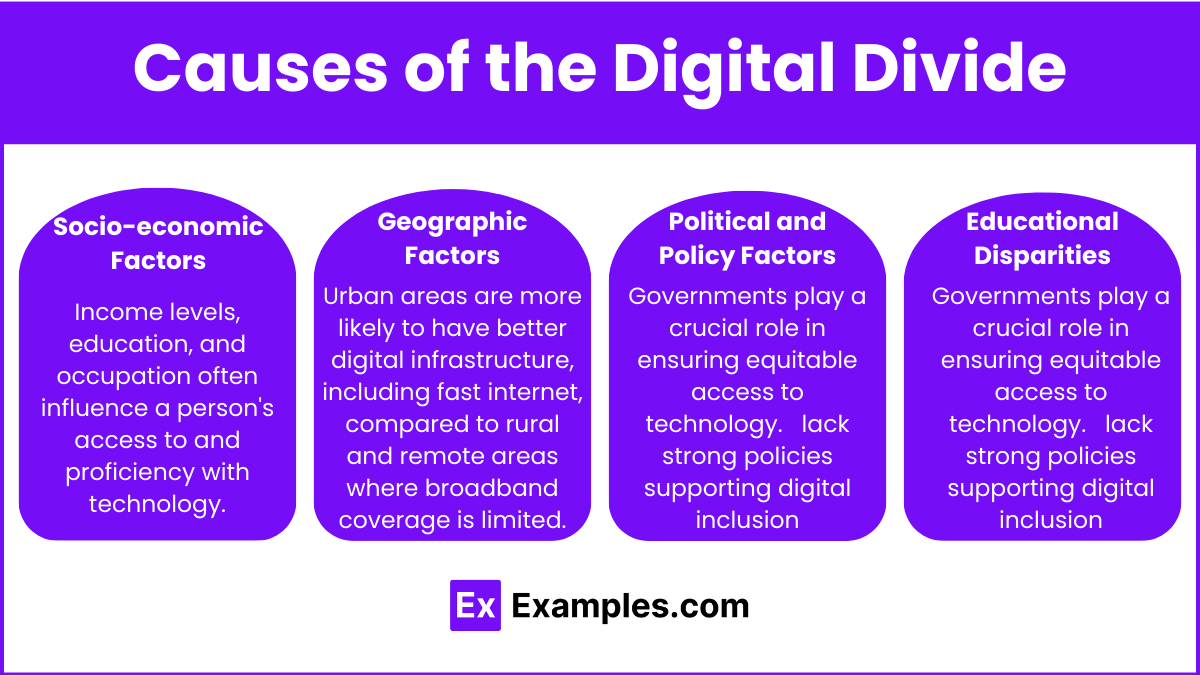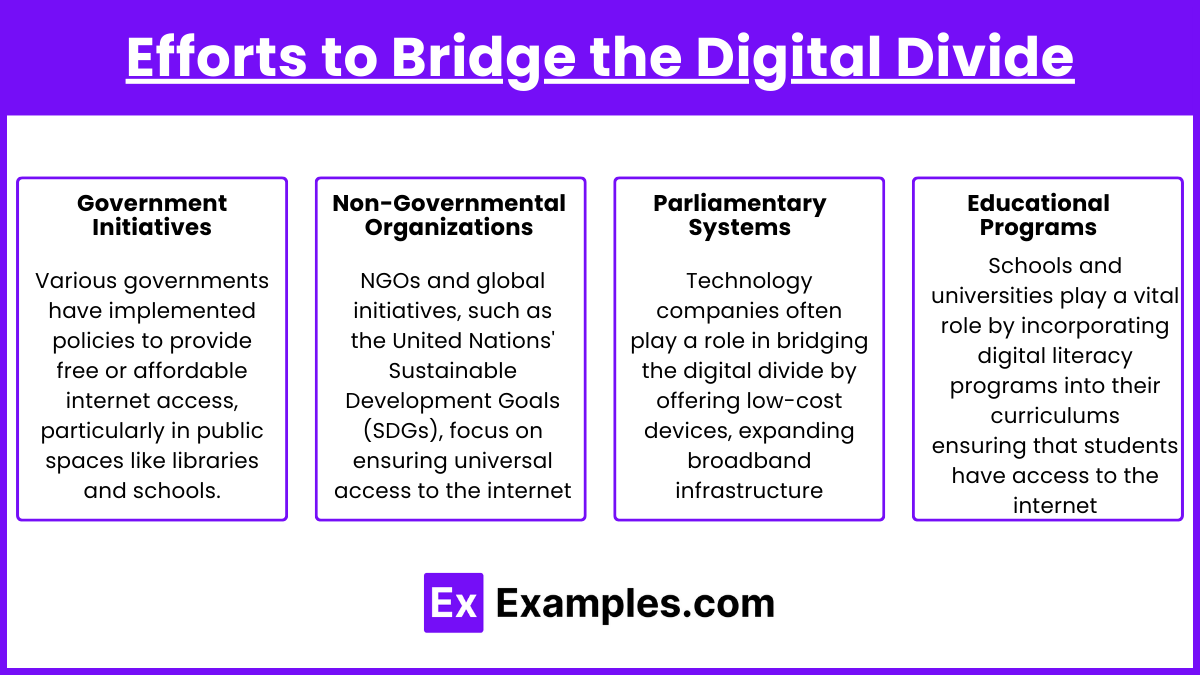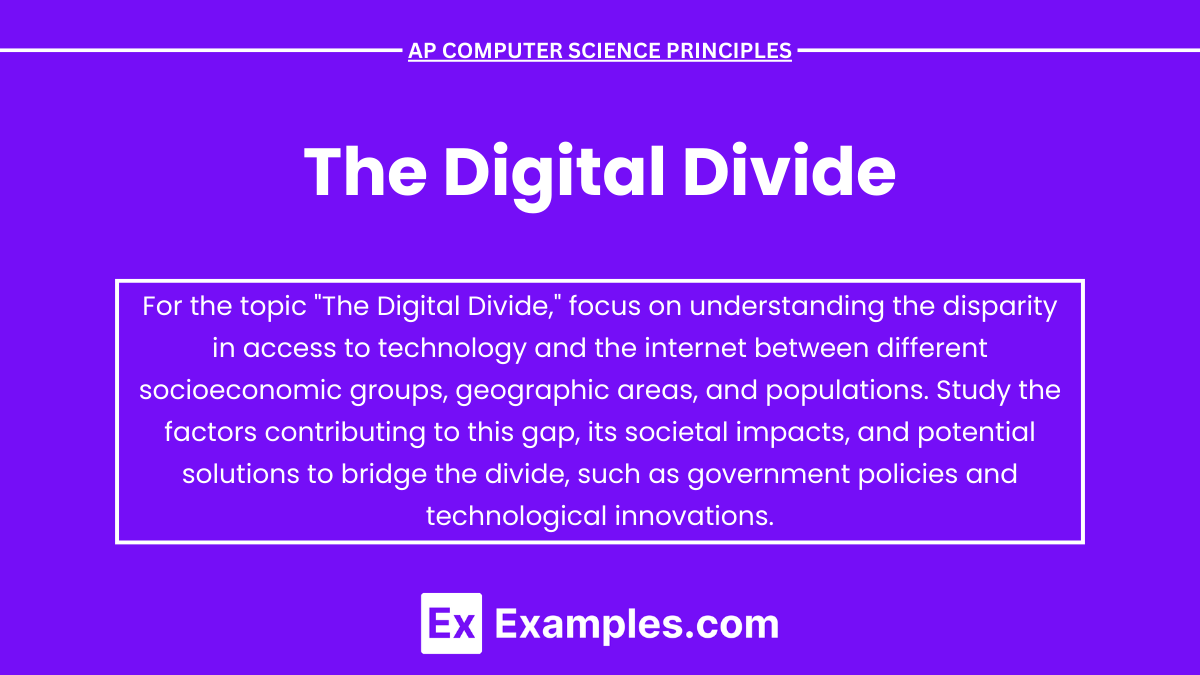The digital divide refers to the disparity between individuals, communities, and nations in accessing and utilizing modern technology such as computers and the internet. This gap is influenced by factors like geography, socioeconomic status, and education. Those on the disadvantaged side of the divide face limitations in education, employment, and communication, deepening social and economic inequalities. Addressing the digital divide is crucial to promoting digital equity, ensuring everyone can benefit from technology’s advancements and participate in the modern digital world.
Learning Objectives
When studying “The Digital Divide” for AP Computer Science Principles, you should focus on understanding the causes and implications of unequal access to technology, including socioeconomic, geographic, and global factors. Learn about the impacts on education, employment, and social services, as well as the efforts being made to bridge this gap through government policies, nonprofits, and corporate initiatives. Additionally, explore the ethical considerations around digital equity and how unequal access affects opportunities and participation in the digital world.
“The Digital Divide”

The digital divide refers to the gap between individuals or communities who have access to modern information and communication technology (ICT), including the internet, computers, and smartphones, and those who do not. This divide can occur on multiple levels:
- Geographic Divide: People in urban areas often have more access to high-speed internet and advanced technology compared to those in rural or remote areas, where infrastructure is limited or absent.
- Socioeconomic Divide: Wealthier individuals or families are more likely to afford devices and internet access compared to lower-income groups. Access to technology becomes a financial burden for some, limiting educational and professional opportunities.
- Educational Divide: The level of education plays a role in digital literacy. Those with higher education levels tend to be more familiar with and can better utilize technology for research, communication, and job prospects. In contrast, those with less education may not fully benefit from available resources.
- Global Divide: The digital divide also exists between developed and developing nations. Developed countries have better technology infrastructure and greater digital access, while developing nations face barriers due to costs, lack of infrastructure, or political restrictions.
Causes of the Digital Divide

- Socio-economic Factors: Income levels, education, and occupation often influence a person’s access to and proficiency with technology. Wealthier individuals tend to have better access to high-quality devices and internet services.
- Geographic Factors: Urban areas are more likely to have better digital infrastructure, including fast internet, compared to rural and remote areas where broadband coverage is limited.
- Political and Policy Factors: Governments play a crucial role in ensuring equitable access to technology. Countries or regions that lack strong policies supporting digital inclusion tend to suffer from a wider digital divide.
- Educational Disparities: Schools in wealthier areas are better equipped with technology, allowing students more opportunities to develop digital skills, while underfunded schools may lack the necessary infrastructure for students to learn digital literacy.
Efforts to Bridge the Digital Divide

- Government Initiatives: Various governments have implemented policies to provide free or affordable internet access, particularly in public spaces like libraries and schools. Some also offer subsidies for low-income families to purchase devices.
- Non-Governmental Organizations (NGOs): NGOs and global initiatives, such as the United Nations’ Sustainable Development Goals (SDGs), focus on ensuring universal access to the internet and improving digital literacy in underserved areas.
- Private Sector Involvement: Technology companies often play a role in bridging the digital divide by offering low-cost devices, expanding broadband infrastructure, and investing in digital skills training programs.
- Educational Programs: Schools and universities play a vital role by incorporating digital literacy programs into their curriculums, ensuring that students have access to the internet and the necessary skills to navigate the digital world.
Examples
Example 1: Urban vs. Rural Divide
In many countries, urban areas benefit from high-speed internet and advanced infrastructure, while rural areas often lack access to reliable broadband. For example, in the United States, rural communities may only have access to satellite internet, which is slower and more expensive than urban broadband options. This limits opportunities for online education, telecommuting, and access to digital resources.
Example 2: Economic Inequality
Families with lower incomes may struggle to afford computers, smartphones, or monthly internet bills. This economic divide affects students who need technology for schoolwork, as well as adults seeking job opportunities or online training. For example, during the COVID-19 pandemic, many students in low-income households could not attend virtual classes due to a lack of devices or stable internet, exacerbating educational gaps.
Example 3: Global North vs. Global South
There is a significant digital divide between developed and developing nations. Developed countries, like those in the Global North, have widespread internet access and advanced digital infrastructure. In contrast, countries in the Global South, such as parts of Africa and South Asia, face challenges due to the high cost of technology and limited access to electricity and internet infrastructure. This gap hinders economic development and global communication.
Example 4: Educational Access Divide
Students in wealthy, well-funded schools have access to the latest technology, including laptops, tablets, and high-speed internet, which supports digital learning. However, students in underfunded schools may only have limited or outdated technology. For instance, some public schools in poorer districts lack enough computers for every student, creating a digital learning gap that can affect academic performance and future opportunities.
Example 5: Language and Digital Literacy
The digital divide also exists in terms of digital literacy and language barriers. Many people, especially in developing countries, may not know how to use modern technology or the internet, limiting their ability to access information and services. For example, a rural farmer in a developing country might not benefit from available online resources because they are in a language they do not understand, or they lack the skills to navigate the digital world effectively. This perpetuates social and economic exclusion.
Multiple Choice Questions
Question 1
What is the primary cause of the digital divide?
A) Lack of interest in technology
B) Economic and geographic disparities
C) Over-reliance on technology in modern society
D) Technological advancement in urban areas only
Answer: B
Explanation: The primary cause of the digital divide is rooted in economic and geographic disparities. Wealthier populations or urban areas tend to have better access to technology due to infrastructure availability and financial ability, while rural areas and lower-income communities face barriers to accessing the internet and devices. This creates an unequal distribution of technological benefits, leading to the digital divide.
Question 2
Which of the following is not a common impact of the digital divide?
A) Increased educational inequality
B) Improved employment opportunities for everyone
C) Social isolation in disadvantaged communities
D) Economic disadvantages for those without access to technology
Answer: B
Explanation: The digital divide generally leads to reduced employment opportunities for those without access to technology, not improved opportunities. People who lack access to the internet and computers often miss out on job openings, remote work possibilities, and skill development programs, which exacerbates economic and social inequality.
Question 3
Which of the following is an effective approach to bridging the digital divide?
A) Encouraging people to buy more advanced devices
B) Improving internet infrastructure in rural and underserved areas
C) Limiting access to technology in urban areas
D) Increasing the number of social media platforms
Answer: B
Explanation: One of the most effective ways to bridge the digital divide is to improve internet infrastructure in rural and underserved areas. By enhancing infrastructure, communities that lack access to high-speed internet and other technological resources can participate more fully in the digital world. This approach is crucial in closing the gap caused by geographic and economic disparities.


